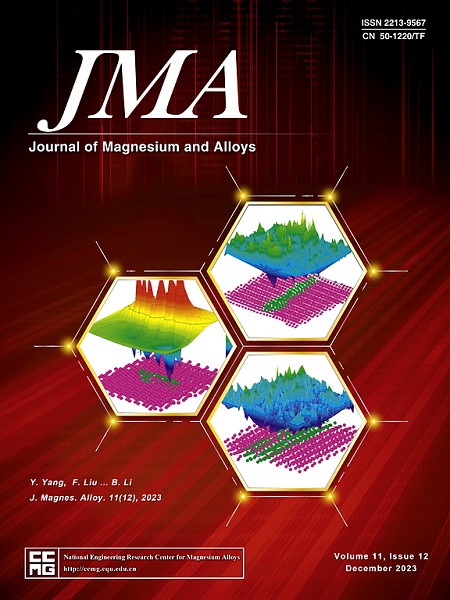Mo2C MXene对氢化镁储氢的有效催化作用
IF 15.8
1区 材料科学
Q1 METALLURGY & METALLURGICAL ENGINEERING
引用次数: 0
摘要
氢化镁(MgH2)因其高储氢容量和低成本而受到广泛关注,但其缓慢的动力学限制了其实际应用。本文首次构建了二维Mo2C MXene,以激发MgH2中的高效储氢。加入10 wt% Mo2C MXene后,开始脱氢温度降至225℃,与接收MgH2相比降低了117℃。在300℃条件下,含10 wt% mo2c的MgH2样品在13 min内可快速释放6.7 wt% H2,在200℃条件下,氢释放后的产物在12 min内可吸附6.0 wt% H2,表现出优异的加氢和脱氢动力学。此外,MgH2 - 10 wt% Mo2C的活化能(Ea)(107.58±1.57 kJ/mol)明显低于纯MgH2的活化能(130.45±1.97 kJ/mol),降低的活化能解释了脱氢温度降低和动力学增强的原因。微观结构表征表明,球磨过程中形成的Mo-物种(Mo0和Mo2+)作为活性物种加速了MgH2的加氢/脱氢反应,且均匀分布的活性物种和Mo与O的相互作用共同促进了MgH2的储氢性能。本文章由计算机程序翻译,如有差异,请以英文原文为准。

Effective catalytic effects of Mo2C MXene on the hydrogen storage in magnesium hydride
Magnesium hydride (MgH2) has received widespread attention because of its high hydrogen capacity and low cost, but the sluggish kinetics limited its practical application. Herein, the two-dimensional Mo2C MXene was constructed to motivate the efficient hydrogen storage in MgH2 for the first time. After doping 10 wt% Mo2C MXene, the starting dehydriding temperature was lowered to 225 °C, presenting a 117 °C reduction compared with that of as-received MgH2. The 10 wt% Mo2C-containing MgH2 sample could rapidly release 6.7 wt% H2 in 13 min at 300 °C, and the product after hydrogen release could absorb 6.0 wt% H2 in 12 min at 200 °C, showing superior hydriding and dehydriding kinetics. Moreover, the activation energy (Ea) of MgH2–10 wt% Mo2C (107.58 ± 1.57 kJ/mol) was obviously lower than that of pure MgH2 (130.45 ± 1.97 kJ/mol), and the reduced activation energy explained the reduced dehydrogenation temperature and enhanced kinetics. Microstructure characterization revealed that Mo-species (Mo0 and Mo2+) formed during ball milling served as active species accelerated the hydriding/dehydriding reactions, and the uniformly distributed active species and the interaction between Mo and O jointly promoted the hydrogen storage properties of MgH2.
求助全文
通过发布文献求助,成功后即可免费获取论文全文。
去求助
来源期刊

Journal of Magnesium and Alloys
Engineering-Mechanics of Materials
CiteScore
20.20
自引率
14.80%
发文量
52
审稿时长
59 days
期刊介绍:
The Journal of Magnesium and Alloys serves as a global platform for both theoretical and experimental studies in magnesium science and engineering. It welcomes submissions investigating various scientific and engineering factors impacting the metallurgy, processing, microstructure, properties, and applications of magnesium and alloys. The journal covers all aspects of magnesium and alloy research, including raw materials, alloy casting, extrusion and deformation, corrosion and surface treatment, joining and machining, simulation and modeling, microstructure evolution and mechanical properties, new alloy development, magnesium-based composites, bio-materials and energy materials, applications, and recycling.
 求助内容:
求助内容: 应助结果提醒方式:
应助结果提醒方式:


